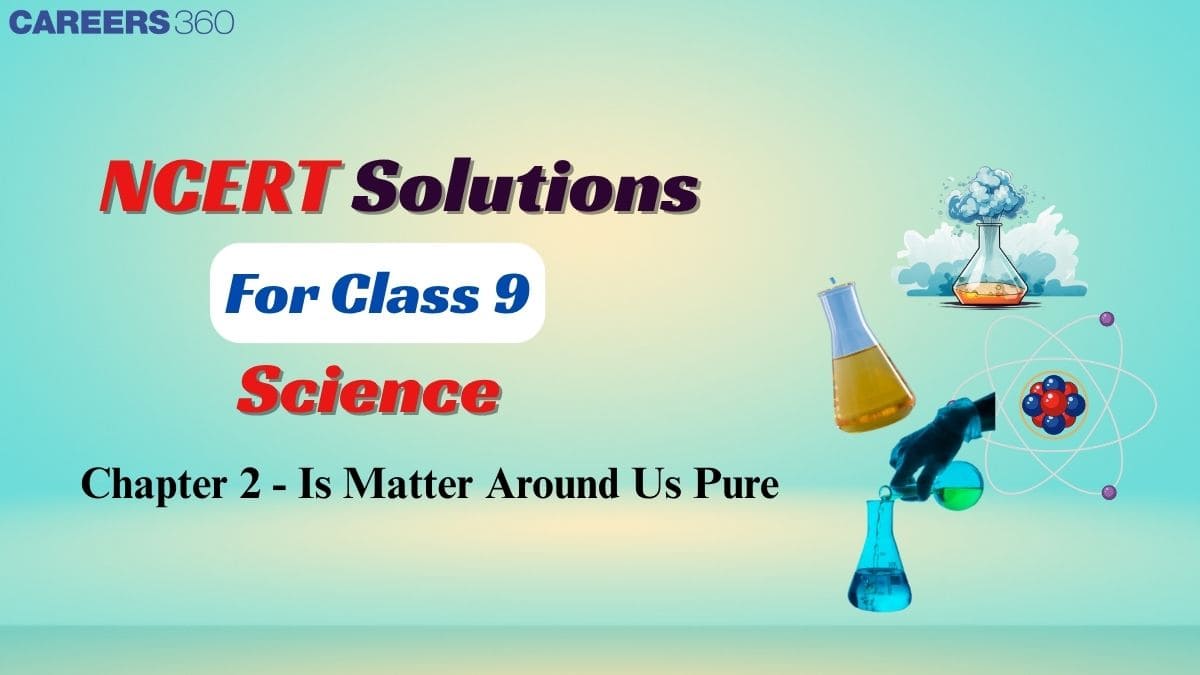Aakash Repeater Courses
ApplyTake Aakash iACST and get instant scholarship on coaching programs.
Have you ever wondered why oil does not dissolve in water, while salt dissolves in water, or sugar completely dissolves in water, while sand settles at the bottom? All these observations are linked to the concept of the purity of matter. ‘Is matter around us pure’ is one of the important chapters as it forms the foundation of advanced topics, and this chapter also helps students to understand some real-life phenomena. Everything around us is a matter, whether it is the air we breathe, the water we drink, or the food we eat.

Objects around us are categorized as either pure or a mixture. It is very crucial to understand whether the matter around us is pure or not. The NCERT Solutions Class 9 Science of Chapter 2 are designed by our subject experts in a very detailed and comprehensive manner that will help the students to understand the concepts and will improve their accuracy. These NCERT solutions cover all the questions mentioned at the end of the chapter and additional questions mentioned in between the chapters.
Students can download the PDF from the link below and can use it later for quick revision
The detailed solution for intext-questions are provided below
Topic 2.1 What is a mixture?, Page 15
Question 1. What is meant by a substance?
Answer:
Substance-
A substance is a matter that consists of a single type of particle and has specific properties. For example, tin, sulfur, pure sugar (sucrose), etc.
Question 2. List the points of differences between homogeneous and heterogeneous mixtures.
Answer:
The differences between homogeneous and heterogeneous mixtures-
| HOMOGENEOUS | HETEROGENOUS |
| 1. It has uniform compositions. 2. No visible boundaries of separation. 3. It consists of only one phase. examples- sugar + water = sugar solution | 1. It does not have a uniform composition 2. Visible boundaries of separation 3. They consist of more than one phase. examples- sugar +sand = sugar + sand |
Topic 2.2 What is a solution?, Page 18
Question 1. Differentiate between homogeneous and heterogeneous mixtures with examples.
Answer:
Homogeneous Mixture: It is a mixture in which different constituents are mixed uniformly and these constituents cannot be easily separated.
Example: Sugar solution, soda, water, soft drinks, vinegar, air, etc.
But,
Heterogeneous mixtures: It is a mixture in which different constituents are not mixed uniformly and the constituents can be easily seen and can be easily separated.
Example: Sugar and sand mixture, milk, ink, paint, wood, blood, etc.
Question 2. How are sol, solution and suspension different from each other?
Answer:
The difference between sol, solution and suspension are given below:
| Sol(Colloids) | Suspension | Solution |
| 1. Heterogeneous mixture | 1. Heterogeneous mixture | 1.Homogeneous mixture |
| 2. We cannot see the size of the particle with the naked eye. | 2. Particles are visible to the human naked eye | 2. The particles are not visible to the naked eye. |
| 3. They can scatter the beam of light passing through them | 3. Scatters the beam of light passing through them | 3. unable to scatter the beam of light. |
| 4. Solute particles cannot be separated by filtration and sedimentation. | 4. Solute particles can be separated by filtration | 4. Solute particles cannot be separated by filtration and sedimentation. |
Answer:
Given that,
Mass of solute (sodium chloride) = 36 g =
Mass of water (as a solvent) = 100 g =
Therefore, the total mass of solution = 100 + 36 = 136 g =
According to the question,
Concentration =
Hence, the concentration of the solution at 293 K is 26.47%
Topic 2.3 Separating the components of a mixture
Answer:
The mixture of kerosene and petrol which are miscible with each other can be separated by the distillation method.
Take the mixture in a distillation flask and fit it with the thermometer. Heat the mixture slowly. As the boiling point of petrol is lower than that of kerosene, so, petrol vaporizes first. It condenses in the condenser and is collected from the outlet.
And thus kerosene is left in the flask.
Question 2. Name the technique to separate
(i) butter from curd,
(ii) salt from sea-water
(iii) camphor from salt.
Answer:
The following techniques are used to separates them-
(i) Centrifugation method
(ii) Evaporation and
(iii) Sublimation.
Question 3. What type of mixtures are separated by the technique of crystallization?
Answer:
The crystallization technique is used to purify solids.
In this method, pure solids can be separated in the form of its crystals from the solution. For example- salts from seawater can be separated by this method.
Topic 2.4 Physical and Chemical changes, Page 19
Question 1 Classify the following as chemical or physical changes:
• cutting of trees,
• melting of butter in a pan,
• rusting of almirah,
• boiling of water to form steam,
• passing of electric current, through water and the water breaking down into hydrogen and oxygen gases,
• dissolving common salt in water,
• making a fruit salad with raw fruits, and
• burning of paper and wood
Answer:
Physical changes-
Chemical changes-
Question 2. Try segregating the things around you as pure substances or mixtures.
Answer:
Pure substance - Water, sugar, and gold
Mixtures- plastic papers, air, and milk
Question 1. Which separation techniques will you apply for the separation of the following?
(a) Sodium chloride from its solution in water.
(b) Ammonium chloride from a mixture containing sodium chloride and ammonium chloride.
(c) Small pieces of metal in the engine oil of a car.
(d) Different pigments from an extract of flower petals.
(e) Butter from curd.
(f) Oil from water.
(g) Tea leaves from tea.
(h) Iron pins from sand.
(i) Wheat grains from husk.
(j) Fine mud particles suspended in water.
Answer:
The following separation techniques are used to separate-
a) Sodium chloride from its solution in water. by Evaporation, method
b) Ammonium chloride from a mixture containing sodium chloride and ammonium chloride. by Sublimation
c) Small pieces of metal in the engine oil of a car. by filtration.
d) Different pigments from an extract of flower petals. by chromatography,
e) Butter from curd. by centrifugation,
f) Oil from water. by separation funnel
g) Tea leaves from tea. by filtration,
h) Iron pins from sand. by magnetic separation,
i) Wheat grains from husk. by winnowing or sedimentation,
j) Fine mud particles suspended in water. by decantation and filtration .
Answer:
The steps for making a tea-
What mass of potassium nitrate would be needed to produce a saturated solution of potassium nitrate in 50 grams of water at 313 K?
.png)
Answer:
We have,
Mass of potassium nitrate = 62g in 100 g of water
Therefore, according to the question,
Mass of potassium nitrate in 50 g of water at 313K
Question 3.(b) Pragya tested the solubility of three different substances at different temperatures and collected the data as given below (results are given in the following table, as grams of a substance dissolved in 100 grams of water to form a saturated solution).
Pragya makes a saturated solution of potassium chloride in water at 353 K and leaves the solution to cool at room temperature. What would she observe as the solution cools? Explain.
.png)
Answer:
Pragya will observe that, on cooling the saturated solution, the crystals of potassium chloride will be obtained.
Find the solubility of each salt at 293 K. Which salt has the highest solubility at this temperature?
.png)
Answer:
The solubility of each salt at 293K is
What is the effect of a change in temperature on the solubility of a salt?
.png)
Answer:
Solubility is directly proportional to the temperature.
Therefore, on increasing temperature, the solubility of salt increases.
Question 4. (a) Explain the following giving examples.
saturated solution
Answer:
Saturated solution - In a given solvent, when no more solute can be dissolved in a solution at a given temperature is called a saturated solution.
Question 4. (b) Explain the following giving examples
pure substance
Answer:
Pure substance -
A pure substance is a matter that consists of a single type of particle and has specific properties. For example, tin, sulphur, pure sugar (sucrose), etc.
Question 4. (c) Explain the following giving examples.
colloid
Answer:
colloid -
A colloid is a solution in which the solute particle is larger in size compared to the true solution. It is a heterogeneous mixture. Because of the small size of colloidal particles, we cannot see them with our naked eyes. For example, milk and blood.
Question 4. (d) Explain the following giving examples.
(d) suspension
Answer:
Suspension-
It is a heterogeneous solution in which the solute particles do not dissolve in the solvent but remain suspended throughout the bulk of the medium. Particles are visible by the naked eye. Chalkwater is an example of this type of solution.
Question 5. Classify each of the following as a homogeneous or heterogeneous mixture.
soda water, wood, air, soil, vinegar, filtered tea.
Answer :
The mixture of the following is homogeneous in nature-
Soda water, vinegar, and filtered tea, as there are no separation boundaries in their solution.
Heterogeneous - Wood, air, and soil. As we can easily see the separation boundaries.
Question 6. How would you confirm that a colourless liquid given to you is pure water?
Answer:
By boiling the give colourless water, we can check whether it is pure or not. If it is pure,e then the water boils at 100
This is because the melting and boiling points of a pure substance don't change.
Question 7. Which of the following materials fall in the category of a “pure substance”?
(a) Ice
(b) Milk
(c) Iron
(d) Hydrochloric acid
(e) Calcium oxide
(f) Mercury
(g) Brick
(h) Wood
(i) Air
Answer:
A pure substance is a matter that consists of a single type of particle and has specific properties-
Therefore, the following given substances are '' pure substances" -
Question 8. Identify the solutions among the following mixtures.
(a) Soil
(b) Seawater
(c) Air
(d) Coal
(e) Soda water
Answer:
A solution is a homogeneous mixture of two or more two substances.
So, according to the definition, out of the given seawater, air, and soda water are examples of solutions.
Question 9. Which of the following will show the “Tyndall effect”?
(a) Salt solution
(b) Milk
(c) Copper sulfate solution
(d) Starch solution.
Answer:
Tyndall effect is shown by the colloidal solution and suspension, and it is not shown by a true solution.
Therefore, in the above-given solution, only the milk and starch solution will be able to scatter the light and hence show the Tyndall effect.
Question 10. Classify the following into elements, compounds, and mixtures.
(a) Sodium
(b) Soil
(c) Sugar solution
(d) Silver
(e) Calcium carbonate
(f) Tin
(g) Silicon
(h) Coal
(i) Air
(j) Soap
(k) Methane
(l) Carbon dioxide
(m) Blood
Answer:
Elements cannot be broken down into any simpler substance. and the compounds have fixed composition can be broken down into elements by chemical or electrochemical reactions. Mixtures have no fixed composition; they are either homogeneous or heterogeneous.
Therefore, Sodium, Silver, Tin, and Silicon are elements.
Question 11. Which of the following are chemical changes?
(a) Growth of a plant
(b) Rusting of iron
(c) Mixing of iron filings and sand
(d) Cooking of food
(e) Digestion of food
(f) Freezing of water
(g) Burning of a candle.
Answer:
Given following are examples of chemical changes-
Question 1. Define a pure substance. Give two examples.
Answer:
A pure substance is a single kind of matter that has a uniform composition and the same properties throughout.
Examples: Distilled water and oxygen gas.
Question 2. Name and explain any two methods used for the separation of components of a mixture.
Answer:
Filtration- Used to separate an insoluble solid from a liquid. For example, sand can be separated from water using a filter paper.
Evaporation- Used to separate a dissolved solid from a liquid. For instance, salt can be separated from salt water by heating it until the water evaporates, leaving the salt behind.
Question 3. What is a solution? Mention its three main properties.
Answer:
A solution is a homogeneous mixture of two or more substances.
The three properties are-
It has a uniform composition throughout.
The particles are so small that they cannot be seen with the naked eye.
The solute does not settle down and cannot be separated by filtration.
Question 4. How would you separate a mixture of salt and sand?
Answer:
To separate salt and sand, we can
Add water to the mixture. Salt dissolves, sand does not.
Filter the mixture to separate sand (residue).
Evaporate the filtrate (salt water) to get salt crystals.
Approach is crucial to solve the questions effectively. The following are the points that can help you to build a good approach
1. First step is to learn the key definitions
Try to understand important terms like mixture, compound, solution, suspension, colloid, solute, solvent, etc. These are frequently asked in both short and long answer questions.
2. Learn the differences
Learn to know the differences between homogeneous and heterogeneous mixtures. You can practice by giving everyday examples for each.
Also, focus on methods like filtration, evaporation, distillation, sublimation, and centrifugation. Questions are often asked from activities based on these.
3. Practice flowcharts and diagrams
Draw neat, labeled diagrams for separation processes and solubility experiments to strengthen your understanding and presentation.
4. Solve the questions
Try to attempt all in-text and exercise questions in your own words using textbook language. Focus on understanding and not just memorizing. Revise the concepts
and also solve the NCERT exemplar for better understanding.
2.2 What is a Solution?
2.2.2 What is a Suspension?
2.2.3 What is a Colloidal Solution?
2.3 Physical and Chemical Changes
2.4 What are the types of pure substances
2.4.1 Elements
2.4.2 Compounds
Density (ρ) = Mass (m) / Volume (V)
This formula relates the density of a substance to its mass and volume, helping us determine the compactness of a material.
This formula calculates the molarity of a solution, which represents the concentration of a solute in a given volume of the solution.
This formula helps us determine the percentage by mass of a solute in a solution, providing insights into the composition of the solution.
This formula allows us to calculate the number of water molecules associated with a hydrated salt.
Follow the link below to get the NCERT chapter-wise solutions:
|
NCERT Solutions for Class 9 Chapter 1 Matter in Our Surroundings |
|
NCERT Solutions for Class 9 Chapter 2 Is Matter Around Us Pure |
|
NCERT Solutions for Class 9 Chapter 5 The Fundamental Unit of Life |
|
NCERT Solutions for Class 9 Chapter 8 Force and Laws of Motion |
|
NCERT Solutions for Class 9 Chapter 12 Improvement in Food Resources |
Students can also download the NCERT solutions for other subjects as well
Get your hands on the NCERT books and syllabus by following the links below
A pure substance is made up of only one kind of particle and has a fixed composition. A mixture contains two or more different substances (elements or compounds) that are physically mixed together but not chemically combined. The components of a mixture retain their individual properties and can be separated by physical methods.
A solution is a homogeneous mixture of two or more substances. One substance (the solute) dissolves in another substance (the solvent). Examples: Sugar dissolved in water, iodine dissolved in alcohol (called tincture of iodine).
A suspension is a heterogeneous mixture in which solid particles are dispersed in a liquid but are not dissolved. The particles are large enough to be seen with the naked eye and will settle down over time. Example: Muddy water, chalk powder in water.
The Tyndall effect is the scattering of light by the particles in a colloid or a very fine suspension. This makes the path of a beam of light visible as it passes through the mixture. The Tyndall effect is not observed in true solutions because the particles are too small to scatter light
Evaporation is used to separate a soluble solid (like salt) from a liquid (like water). The mixture is heated, causing the liquid to evaporate and leave the solid behind.

Take Aakash iACST and get instant scholarship on coaching programs.

This ebook serves as a valuable study guide for NEET 2025 exam.

This e-book offers NEET PYQ and serves as an indispensable NEET study material.

As per latest syllabus. Physics formulas, equations, & laws of class 11 & 12th chapters
As per latest syllabus. Chemistry formulas, equations, & laws of class 11 & 12th chapters
As per latest 2024 syllabus. Study 40% syllabus and score upto 100% marks in JEE